List of United States Navy aircraft squadrons
This is a list of active United States Navy aircraft squadrons. Deactivated or disestablished squadrons are listed in the list of inactive United States Navy aircraft squadrons.
Navy aircraft squadrons are composed of several aircraft (from as few as about four to as many as about a dozen), the officers who fly them, the officers and sailors who maintain them and administrative support officers and sailors. Some of the units listed in this article are not designated as "squadrons", but they all operate U.S. Navy aircraft in some capacity.
Squadrons and their history are listed in the Dictionary of American Naval Aviation Squadrons (DANAS).
Squadron organization
[edit]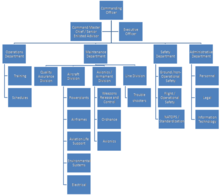
Most active duty squadrons are commanded by a commanding officer (CO) who holds the rank of commander.[a] Second in command is the executive officer (XO), who also holds the rank of commander. The XO typically assumes command of the squadron after approximately 15 months. There are typically four functional departments – Operations, Maintenance, Safety/NATOPS, and Administration – each led by a lieutenant commander functioning as the department head. Within the departments are divisions (each typically headed by a lieutenant) and branches (headed by a lieutenant, junior grade or a chief petty officer).
The CO of a Reserve squadron is also a commander, as is the XO who will also assume command after approximately 15 months. However, reserve squadron demographics are typically older and more senior in rank than their active duty squadron counterparts. Department heads in reserve squadrons are typically senior lieutenant commanders, although some may be recently promoted commanders. Where this difference in maturity level becomes more apparent is at the division officer level. Since most officers in reserve squadrons previously served on active duty in the Regular Navy in a flying status for eight to ten or more years, they are typically already lieutenant commanders, or achieve that rank shortly after transferring to the Navy Reserve. As a result, lieutenants are a minority and lieutenants, junior grade, are practically non-existent in reserve squadrons. As a result, divisions are typically headed by lieutenant commanders and branches by lieutenants, senior chief petty officers or chief petty officers.
Types of squadrons
[edit]Squadrons are categorised in various ways: active versus US Navy Reserve, land-based or sea-based, by aircraft type -fixed wing, rotary wing (helicopter. tiltrotor), unmanned aerial vehicle (UAV), and by mission. Unlike the USAF, US Army, and USMC, the US Navy does not refer to units that carry out as maintenance, medical, administrative or other units as "squadrons"; for the USN a squadron is a unit of aircraft, ships, submarines or boats. There are two exceptions: Tactical Air Control Squadrons (TACRON) consists of personnel specialized in the control of aircraft in support of amphibious operations; and the operating units of Naval Special Warfare Development Group colloquially known as "SEAL Team Six", are called "squadrons" named by color (these squadrons are the organizational equivalent of a "regular" SEAL Team). .
US Navy Reserve squadrons are manned by a combination of full-time and part-time reservists. In general, reserve squadrons share the same missions as their active counterparts, although there are Reserve missions (e.g., Adversary and Fleet Logistics Support) that have no Active counterpart.
At any one time, the US Navy has approximately 600 aircraft that are associated with particular ships. There are also several thousand additional Navy aircraft that are capable of shipboard operations, but are not associated with a ship and several hundred land-based aircraft that are not capable of shipboard operations.
Squadron designations
[edit]Navy aircraft squadrons can be properly referred to by designation or nickname. A squadron's designation describes its mission and therefore generally the type of aircraft it flies.
- The Formal form designation (e.g., Strike Fighter Squadron Eight Six) indicates the mission.
- A subset of the formal form designation is a Navy acronym format in capital letters, e.g., STKFITRON EIGHT SIX
- The abbreviated designation (e.g., VFA-86) also indicates the type and mission, as each of the letters has a meaning. In this case, "V" stands for fixed wing, "F" stands for fighter, and "A" stands for attack.
- Nickname – e.g., "Sidewinders".
Note: The presence of an "M" after the "V" (or "H" in the case of a helicopter squadron) denotes a USMC squadron: i.e. VMFA, VMR, HMLA.
A single squadron can carry a number of designations through its existence. Chief Of Naval Operations Instruction 5030.4G governs the squadron designation system. A squadron comes into existence when it is "established". Upon establishment it receives a designation, for example Patrol Squadron One ("VP-1"). During the life of the squadron it may be "redesignated" one or more times, the Navy's oldest currently active squadron is VFA-14 and it has been redesignated 15 times since it was established in 1919. Over the history of U. S. Naval Aviation there have been many designations which have been used multiple times (re-used) resulting in multiple unrelated squadrons bearing the same designation at different times. See also List of Inactive United States Navy aircraft squadrons.[1]
Fixed wing squadrons
[edit]Navy fixed wing squadron designations start with the letter "V". In 1920 with issuance of General Order 541, two overall types of aircraft were identified and assigned permanent letters; lighter than air types were identified by the letter Z and heavier than air types by the letter V.[2] The use of letter abbreviations for squadrons was promulgated in the "Naval Aeronautic Organization for Fiscal Year 1923" which is the first known record associating the abbreviated Aircraft Class Designations with abbreviated squadron designations.[3] In 1948 the Navy established its first two operational helicopter squadrons designating them as Helicopter Utility Squadrons and gave them the designation "HU" ('Helicopter, Utility'). From that point on squadrons which flew rotary wing aircraft were designated with the first letter of "H" . There were two exceptions the use of "RVAH" to denote Reconnaissance Attack Squadrons which operated the RA-5C Vigilante during the 1960s and 1970s and the use of "RVAW" from 1967 to 1983 to designate the Airborne Early Warning (VAW) Fleet Replacement Squadrons.
Electronic Attack (VAQ)
[edit]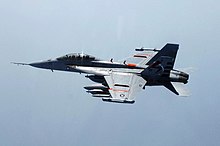
The VAQ (V-fixed wing, A-attack, Q-electronic). designation was established in 1968 to designate "Tactical Electronic Warfare Squadron".[4] On 30 March 1998 the name of the designation was changed to "Electronic Attack Squadron"[5] and all VAQ squadrons then in existence were renamed from "Tactical Electronic Warfare Squadron" to "Electronic Attack Squadron".
Electronic Attack Squadrons consists of seven Boeing EA-18G Growlers (with the exception of the Fleet Replacement Squadron which has more). The primary mission of the Growler is Suppression of Enemy Air Defenses (SEAD) in support of strike aircraft and ground troops by interrupting enemy electronic activity and obtaining tactical electronic intelligence within the combat area.
Most VAQ squadrons are carrier based, however a number are "expeditionary", deploying to overseas land bases. When not deployed most are 'home-ported' at NAS Whidbey Island, WA except VAQ-141, which is forward deployed to Marine Corps Air Station Iwakuni, Japan.[6]
Note: The parenthetical (Second use) and (2nd) appended to some designations in the table below are not a part of the squadron designation system. They are added to indicate that the designation was used more than once during the history of U.S. Naval Aviation to designate a squadron and that these were the second use of that designation.
| Squadron | Insignia | Nickname | Aircraft[7] | Operational commander | Administrative commander | Squadron lineage[5] | Notes |
|---|---|---|---|---|---|---|---|
| VAQ-129 |  |
Vikings | EA-18G | Commander, Electronic Attack Wing Pacific | Commander, Electronic Attack Wing Pacific | VAH-10: 1 May 1961 VAQ-129: 1 Sep 1970 |
Fleet Replacement Squadron based at NAS Whidbey Island |
| VAQ-130 |  |
Zappers | EA-18G | Commander, Carrier Air Wing Three | VAW-13: 1 Sep 1959 VAQ-130: 1 Oct 1968 |
Homeport NAS Whidbey Island | |
| VAQ-131 |  |
Lancers | EA-18G | Commander, Electronic Attack Wing Pacific | VP-920: 1 May 1946-15 Nov 1946 VP-ML-70: 15 Nov 1946-Feb 1950 VP-931: Feb 1950-4 Feb 1953 VP-57: 4 Feb 1953-3 Jul 1956 VAH-4: 3 Jul 1956-1 Nov 1968 VAQ-131: 1 Nov 1968 |
Homeport NAS Whidbey Island Expeditionary Squadron. USNR squadron VP-931 was activated on 2 Sep 1950 for participation in the Korean War[5] | |
| VAQ-132 |  |
Scorpions | EA-18G | Commander, Electronic Attack Wing Pacific | VAH-2: 1 Nov 1955-1 Nov 1968 VAQ-132: 1 Nov 1968–present |
Homeport NAS Whidbey Island Expeditionary Squadron | |
| VAQ-133 (Second use) |
 |
Wizards | EA-18G | Commander, Carrier Air Wing Nine | VAQ-133(2nd): 1 Apr 1996–present | Homeport NAS Whidbey Island There was an earlier squadron designated VAQ-133 also called the "Wizards" which existed from 4 Mar 1969 to Jun 1992 | |
| VAQ-134 |  |
Garudas | EA-18G | Commander, Electronic Attack Wing Pacific | VAQ-134: 17 Jun 1969–present | Homeport NAS Whidbey Island Expeditionary Squadron | |
| VAQ-135 |  |
Black Ravens | EA-18G | Commander, Electronic Attack Wing Pacific | VAQ-135: 15 May 1969 – present | Homeport NAS Whidbey Island Expeditionary Squadron | |
| VAQ-136 |  |
Gauntlets | EA-18G | Commander, Carrier Air Wing Two | VAQ-136: 6 Apr 1973–present | Homeport NAS Whidbey Island | |
| VAQ-137 (Second use) |
 |
Rooks | EA-18G | Commander, Carrier Air Wing Eleven | VAQ-137(2nd): 1 Oct 1996–present | Homeport NAS Whidbey Island There was an earlier squadron designated VAQ-137 also called the "Rooks" which existed from 14 Dec 1973 to 26 May 1994 | |
| VAQ-138 |  |
Yellowjackets | EA-18G | Commander, Electronic Attack Wing Pacific | VAQ-138: 27 Feb 1976–present | Homeport NAS Whidbey Island Expeditionary Squadron | |
| VAQ-139 |  |
Cougars | EA-18G | Commander, Carrier Air Wing Seventeen | VAQ-139: 1 Jul 1983–present | Homeport NAS Whidbey Island | |
| VAQ-140 |  |
Patriots | EA-18G | Commander, Carrier Air Wing SEVEN | VAQ-140: 1 Oct 1985–present | Homeport NAS Whidbey Island | |
| VAQ-141 |  |
Shadowhawks | EA-18G | Commander, Carrier Air Wing Five | VAQ-141: 1 Jul 1987–present | Forward deployed to MCAS Iwakuni, Japan | |
| VAQ-142 (Second use) |
 |
Gray Wolves | EA-18G | Commander, Carrier Air Wing EIGHT | VAQ-142(2nd): 1 Apr 1997–present | Homeport NAS Whidbey Island There was an earlier squadron designated VAQ-142 called the "Grim Watchdogs" which existed from 1 Jun 1988 to March 1991 | |
| VAQ-144 |  |
Main Battery | EA-18G | Commander, Carrier Air Wing ONE | VAQ-144: 1 Oct 2021–present | Homeport NAS Whidbey Island Adopted "Main Battery" name from former VA-196 which was the last Pacific Fleet A-6E squadron dissestablished in 1997 | |
| VAQ-209 |  |
Star Warriors | EA-18G | Commander, Tactical Support Wing | Commander, Tactical Support Wing | VAQ-209: 1 Oct 1977–present | U.S. Navy Reserve Squadron Homeport NAS Whidbey Island |
Airborne Command & Control (VAW)
[edit]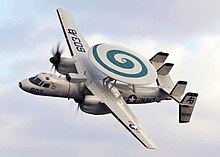

The VAW designation was first created in July 1948 with the establishment of VAW-1 and VAW-2 to designate "Carrier Airborne Early Warning Squadron".[8] It was in use for only one month as in August 1948 VAW-1 and VAW-2 were redesignated "Composite Squadron" VC-11 and VC-12. In 1948 the VAW designation was resurrected[8] when VC-11 and VC-12 were redesignated VAW-11 and VAW-12. In 1967, VAW-11 and VAW-12 which were large land based squadrons that provided detachments of Airborne Early Warning aircraft to deploying Carrier Air Wings were redesignated as wings and each of their detachments were established as separate squadrons. Established from VAW-11 were RVAW-110 (a FRS), VAW-111, 112, 113, 114, 115, 116 and established from VAW-12 were RVAW-120 (a FRS), VAW-121, 122, 123.[9] In 2019, the VAW designation was renamed from Carrier Airborne Early Warning Squadron to Airborne Command and Control squadron and all VAW squadrons were renamed "Airborne Command & Control Squadron XXX" while retaining the VAW designation.
Each Carrier Airborne Command and Control squadron consists of four E-2C or five E-2D Hawkeyes except for the Fleet Replacement Squadron which has more. Transition to the E-2D Hawkeye is in progress and should be complete by 2025. The Hawkeye's primary mission is to provide all-weather airborne early warning, airborne battle management and command and control (C2) functions for the carrier strike group and Joint Force Commander. Additional missions include surface surveillance coordination, air interdiction, offensive and defensive counter air control, close air support coordination, time critical strike coordination, search and rescue airborne coordination and communications relay. The E-2 Hawkeye and C-2 Greyhound are built on the same airframe and have many similar characteristics. For this reason, both aircraft are trained for in the same Fleet Replacement Squadron.[10]
When not deployed, they are home-ported at either Naval Station Norfolk, VA or Naval Air Station Point Mugu, CA. The exception is VAW-125, which is forward deployed to MCAS Iwakuni, Japan.
| Squadron Designation | Insignia | Nickname | Aircraft | Operational commander | Administrative commander | Squadron Lineage[5] | Notes |
|---|---|---|---|---|---|---|---|
| VAW-113 |  |
Black Eagles | E-2D | Commander, Carrier Air Wing TWO | Commander, Airborne Command, Control, Logistics Wing | VAW-113: 20 Apr 1967–present | Homeport NAS Pt. Mugu Established from a detachment of VAW-11 |
| VAW-115 |  |
Liberty Bells | E-2D | Commander, Carrier Air Wing Eleven | VAW-115: 20 Apr 1967–present | Homeport NAS Pt. Mugu Established from a detachment of VAW-11 | |
| VAW-116 |  |
Sun Kings | E-2C | Commander, Carrier Air Wing Seventeen | VAW-116: 20 Apr 1967–present | Homeport NAS Pt. Mugu Established from a detachment of VAW-11 | |
| VAW-117 |  |
Wallbangers | E-2D | Commander, Carrier Air Wing Nine | VAW-117: 1 Jul 1974–present | Homeport NAS Pt. Mugu | |
| VAW-120 |  |
Grey Hawks | E-2C E-2D C-2A |
Commander, Airborne Command, Control, Logistics Wing | RVAW-120: 1 Jul 1967-1 May 1983 VAW-120: 1 May 1983 – present |
Fleet Replacement Squadron based at NS Norfolk RVAW-120 established from VAW-12 | |
| VAW-121 |  |
Blue Tails | E-2D | Commander, Carrier Air Wing Seven | VAW-121: 1 Apr 1967–present | Homeport NS Norfolk Established from a detachment of VAW-12 | |
| VAW-123 |  |
Screwtops | E-2C | Commander, Carrier Air Wing THREE | VAW-123: 1 Apr 1967–present | Homeport NS Norfolk Established from a detachment of VAW-12 | |
| VAW-124 |  |
Bear Aces | E-2D | Commander, Carrier Air Wing Eight | VAW-124: 1 Sep 1967–present | Homeport NS Norfolk | |
| VAW-125 |  |
Tigertails | E-2D | Commander, Carrier Air Wing Five | VAW-125: 1 Oct 1968–present | Forward deployed to MCAS Iwakuni Japan | |
| VAW-126 |  |
Seahawks | E-2D | Commander, Carrier Air Wing ONE | VAW-126: 1 Apr 1969–present | Homeport NS Norfolk |
Strike Fighter (VFA)
[edit]
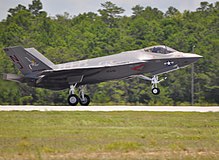
The VFA designation was created in 1980 to designate "Fighter Attack Squadron". The designation was assigned to squadrons equipped with the new F/A-18A Hornet fighter attack aircraft. In 1983 the designation was changed to "Strike Fighter Squadron"[4] and all VFA squadrons in existence at the time were renamed from "Fighter Attack Squadron-___" to "Strike Fighter Squadron-___". The Marine Corps did not participate in this renaming and VMFA squadrons retain the title "Fighter Attack Squadron". A Strike Fighter Squadron consists of either ten or twelve F/A-18E single seat Super Hornets, twelve F/A-18F two seat Super Hornets[11] or ten F-35C Lightning IIs.[12][13] Training squadrons (known as Fleet Replacement Squadrons) have many more aircraft. The Hornet and Super Hornet are all-weather aircraft used for attack and fighter missions. In fighter mode, they are used as a fighter escort and for fleet air defense; in attack mode, they are used for force projection, interdiction and close and deep air support. The Hornet and Super Hornet are also used for Suppression of Enemy Air Defenses (SEAD) and the Super Hornet for aerial refueling.
The F-35C is a fifth-generation strike fighter that was originally planned to replace the F/A-18C Hornet, but expiring F/A-18C service life and delays in F-35C procurement forced the Navy to increase its buy of F/A-18E and F Super Hornets to replace F/A-18C Hornets while awaiting the arrival of the F-35C. The last active component F/A-18C Hornet squadron began its transition to the Super Hornet in February 2019, leaving only a single reserve component F/A-18C Hornet squadron which in 2022 was redesignated a Fighter Composite Squadron and replaced its F/A-18C Hornets with F-5N and F "adversary" aircraft. The first deployable squadron to transition to the F-35C was a Super Hornet squadron. Ultimately each Carrier Air Wing will be equipped with two Super Hornet squadrons and two F-35C squadrons.
VFA squadrons are home-ported at NAS Lemoore, CA or NAS Oceana, VA when not deployed, except for the squadrons of CVW-5 (which are forward deployed to MCAS Iwakuni, Japan).
Note: The parenthetical (1st), (2nd), (3rd) etc... appended to some designations in the lineage column of table below are not a part of the squadron designation system. They are added to indicate that the designation was used more than once during the history of U.S. Naval Aviation and which use of the designation is indicated. Absence indicates that the designation was used only once.
"F/A-18 Hornet strike fighter". USN Fact File. United States Navy.
| Squadron Designation | Insignia | Nickname | Aircraft | Operational Commander | Administrative Commander | Squadron Lineage[5] | Notes |
|---|---|---|---|---|---|---|---|
| VFA-2 |  |
Bounty Hunters | F/A-18F | Commander, Carrier Air Wing TWO | Commander, Strike Fighter Wing Pacific | VF-2(5th): 14 Oct 1942-21 Jul 2003 VFA-2: 21 Jul 2003–present |
Homeport NAS Lemoore |
| VFA-11 |  |
Red Rippers | F/A-18F | Commander, Carrier Air Wing ONE | Commander, Strike Fighter Wing Atlantic | VF-43(4th): 1 Sep 1950-16 Feb 1959 VF-11(3rd): 16 Feb 1959–18 Oct 2005 VFA-11: 18 Oct 2005–present |
Second "Red Rippers" squadron Homeport NAS Oceana |
| VFA-14 |  |
Tophatters | F/A-18E | Commander, Carrier Air Wing Nine | Commander, Strike Fighter Wing Pacific | Air Det Pac Flt: Sep 1919-15 Jun 1920 VT-5(1st): 15 Jun 1920-7 Sep 1921 VP-1-4: 7 Dec 1921–23 Sep 1921 VF-4(1st) 23 Sep 1921-1 Jul 1922 VF-1(1st): 1 Jul 1922-1 Jul 1927 VF-1B(1st): 1 Jul 1927-1 Jul 1934 VB-2B: 1 Jul 1934-1 Jul 1937 VB-3: 1 Jul 1937-1 Jul 1939 VB-4: 1 Jul 1939–15 Mar 1941 VS-41(2nd): 15 Mar 1941-1 Mar 1943 VB-41: 1 Mar 1943-4 Aug 1943 VB-4: 4 Aug 1943–15 Nov 1946 VA-1A: 15 Nov 1946-2 Aug 1948 VA-14: 2 Aug 1948–15 Dec 1949 VF-14(2nd): 15 Dec 1949-1 Dec 2001 VFA-14: 1 Dec 2001–present |
Homeport NAS Lemoore Oldest currently active aircraft squadron in the U. S. Navy |
| VFA-22 |  |
Fighting Redcocks | F/A-18F | Commander, Carrier Air Wing Seventeen | Commander, Strike Fighter Wing Pacific | VF-63: 28 Jul 1948-Mar 1956 VA-63: Mar 1956-1 Jul 1959 VA-22: 1 Jul 1959-4 May 1990 VFA-22: 4 May 1990 – present |
Homeport NAS Lemoore |
| VFA-25 |  |
Fist of the Fleet | F/A-18E | Commander, Carrier Air Wing Eleven | Commander, Strike Fighter Wing Pacific | VT-17: 1 Jan 1943-15 Nov 1946 VA-6B: 15 Nov 1946–27 Jul 1948 VA-65(1st): 27 Jul 1948-1 Jul 1959 VA-25(2nd): 1 Jul 1959-1 Jul 1983 VFA-25: 1 Jul 1983–present |
Homeport NAS Lemoore |
| VFA-27 |  |
Royal Maces | F/A-18E | Commander, Carrier Air Wing Five | Commander, Strike Fighter Wing Pacific | VA-27: 1 Sep 1967-24 Jan 1991 VFA-27: 24 Jan 1991–present |
Forward deployed to MCAS Iwakuni, Japan |
| VFA-31 |  |
Tomcatters | F/A-18E | Commander, Carrier Air Wing EIGHT | Commander, Strike Fighter Wing Atlantic | VF-1B(2nd): 1 Jul 1935-1 Jul 1937 VF-6(2nd): 1 Jul 1937–15 Jul 1943 VF-3(3rd): 15 Jul 1943–15 Nov 1946 VF-3A: 15 Nov 1946-7 Aug 1948 VF-31(2nd): 7 Aug 1948-1 Aug 2006 VFA-31: 1 Aug 2006–present |
Second "Felix the Cat" squadron Homeport NAS Oceana |
| VFA-32 |  |
Swordsmen | F/A-18F | Commander, Carrier Air Wing THREE | Commander, Strike Fighter Wing Atlantic | VBF-3: 1 Feb 1945-15 Nov 1946 VF-4A: 15 Nov 1946-7 Aug 1948 VF-32(2nd): 7 Aug 1948-1 Aug 2006 VFA-32: 1 Aug 2006–present |
Homeport NAS Oceana |
| VFA-34 |  |
Blue Blasters | F/A-18E | Commander, Carrier Air Wing Eleven | Commander, Strike Fighter Wing Atlantic | VA-34(3rd): 1 Jan 1970-30 Aug 1996 VFA-34: 30 Aug 1996–present |
Homeport NAS Oceana Was the last active component F/A-18C Hornet squadron. Began transition to F/A-18E in Feb 2019 |
| VFA-37 |  |
Ragin Bulls | F/A-18E | Commander, Carrier Air Wing EIGHT | Commander, Strike Fighter Wing Atlantic | VA-37: 1 Jul 1967-28 Nov 1990 VFA-37: 28 Nov 1990–present |
Homeport NAS Oceana |
| VFA-41 |  |
Black Aces | F/A-18F | Commander, Carrier Air Wing Nine | Commander, Strike Fighter Wing Pacific | VF-41(4th): 1 Sep 1950-1 Dec 2001 VFA-41: 1 Dec 2001–present |
Homeport NAS Lemoore |
| VFA-81 |  |
Sunliners | F/A-18E | Commander, Carrier Air Wing ONE | Commander, Strike Fighter Wing Atlantic | VA-66(1st): 1 Jul 1955-1 Jul 1955 VF-81(4th): 1 Jul 1955-1 Jul 1959 VA-81: 1 Jul 1959-4 Feb 1988 VFA-81: 4 Feb 1988–present |
Homeport NAS Oceana Established 1 July 1955 as VA-66 and redesignated VF-81 on the same day |
| VFA-83 |  |
Rampagers | F/A-18E | Commander, Carrier Air Wing THREE | Commander, Strike Fighter Wing Atlantic | VF-916: 1 Feb 1951-4 Feb 1953 VF83(3rd): 4 Feb 1953-1 Jul 1955 VA-83: 1 Jul 1955-1 Mar 1988 VFA-83: 1 Mar 1988–present |
Homeport NAS Oceana USNR squadron VF-916 activated on 1 Feb 1951 for the Korean War |
| VFA-86 |  |
Sidewinders | Transitioning to F-35C | Commander, Joint Strike Fighter Wing | Commander, Joint Strike Fighter Wing | VF-921: 1 Feb 1951-4 Feb 1953 VF-84(2nd): 4 Feb 1953-1 Jul 1955 VA-86(2nd): 1 Jul 1955–15 Jul 1987 VFA-86: 15 Jul 1987–present |
Homeport NAS Lemoore USNR squadron VF-921 activated on 1 Feb 1951 for the Korean War |
| VFA-87 |  |
Golden Warriors | F/A-18E | Commander, Carrier Air Wing EIGHT | Commander, Strike Fighter Wing Atlantic | VA-87: 1 Feb 1968-May 1986 VFA-87: May 1986 – present |
Homeport NAS Oceana |
| VFA-94 |  |
Mighty Shrikes | Transitioning to F/A-18E | Commander, Carrier Air Wing Seventeen | Commander, Strike Fighter Wing Pacific | VF-94(2nd): 26 Mar 1952-1 Aug 1958 VA-94(2nd): 1 Aug 1958–24 Jan 1991 VFA-94: 24 Jan 1991–present |
Homeport NAS Lemoore |
| VFA-97 |  |
Warhawks | F-35C | Commander, Carrier Air Wing TWO | Commander, Strike Fighter Wing Pacific | VA-97: 1 Jun 1967-24 Jan 1991 VFA-97: 24 Jan 1991–present |
Homeport NAS Lemoore |
| VFA-102 |  |
Diamondbacks | F/A-18F | Commander, Carrier Air Wing Five | Commander, Strike Fighter Wing Pacific | VA-36(2nd): 1 Jul 1955-1 Jul 1955 VF-102(2nd): 1 Jul 1955-1 May 2002 VFA-102: 1 May 2002 – present |
Forward Deployed to MCAS Iwakuni, Japan Established 1 Jul 1955 as VA-36(2nd) and redesignated VF-102(2nd) on the same day |
| VFA-103 |  |
Jolly Rogers | F/A-18F | Commander, Carrier Air Wing SEVEN | Commander, Strike Fighter Wing Atlantic | VF-103: 1 May 1952-27 Apr 2006 VFA-103: 27 Apr 2006–present |
Third "Jolly Roger" squadron Homeport NAS Oceana |
| VFA-105 |  |
Gunslingers | F/A-18E | Commander, Carrier Air Wing THREE | Commander, Strike Fighter Wing Atlantic | VA-105(2nd): 4 Mar 1968-17 Dec 1990 VFA-105:17 Dec 1990–present |
Homeport NAS Oceana |
| VFA-106 |  |
Gladiators | F/A-18E, F/A-18F | Commander, Strike Fighter Wing Atlantic | Commander, Strike Fighter Wing Atlantic | VFA-106: 27 Apr 1984–present | Fleet Replacement Squadron based at NAS Oceana Adopted nickname and insignia of VA-106 which had been disestablished in 1969 |
| VFA-113 |  |
Stingers | F/A-18E | Commander, Carrier Air Wing TWO | Commander, Strike Fighter Wing Pacific | VF-113: 15 Jul 1948-Mar 1959 VA-113: Mar 1956–25 Mar 1983 VFA-113: 25 Mar 1983–present |
Homeport NAS Lemoore |
| VFA-115 |  |
Eagles | F/A-18E | N/A | Commander, Strike Fighter Wing Pacific | VT-11: 10 Oct 1942-15 Nov 1946 VA-12A: 15 Nov 1946–15 Jul 1948 VA-115: 15 Jul 1948–30 Sep 1996 VFA-115: 30 Sep 1996–present |
Homeport NAS Lemoore |
| VFA-122 |  |
Flying Eagles | F/A-18E, F/A-18F | Commander, Strike Fighter Wing Pacific | Commander, Strike Fighter Wing Pacific | VFA-122: 1 Oct 1998–present | Fleet Replacement Squadron based at NAS Lemoore Adopted nickname and insignia of VA-122 which had been disestablished in 1991 |
| VFA-125 |  |
Rough Raiders | F-35C | Commander, Joint Strike Fighter Wing | Commander, Joint Strike Fighter Wing | VFA-125: 13 Nov 1980–present (inactive 1 Oct 2010 – 12 Jan 2017) |
Fleet Replacement Squadron based at NAS Lemoore Adopted nickname and insignia of VA-125 which had been disestablished in 1977 Deactivated on 1 Oct 2010 as a Hornet FRS and reactivated[1] as a F-35C FRS on 12 Jan 2017 |
| VFA-131 |  |
Wild Cats | F/A-18E | Commander, Carrier Air Wing THREE | Commander, Strike Fighter Wing Atlantic | VFA-131: 3 Oct 1983–present | Homeport NAS Oceana |
| VFA-136 |  |
Knighthawks | F/A-18E | Commander, Carrier Air Wing SEVEN | Commander, Strike Fighter Wing Pacific | VFA-136: 1 Jul 1985–present | Homeport NAS Lemoore |
| VFA-137 |  |
Kestrels | F/A-18E | Commander, Carrier Air Wing Seventeen | Commander, Strike Fighter Wing Pacific | VFA-137: 1 Jul 1985–present | Homeport NAS Lemoore |
| VFA-143 |  |
Pukin' Dogs | F/A-18E | Commander, Carrier Air Wing ONE | Commander, Strike Fighter Wing Atlantic | VF-871: 20 Jul 1950-4 Feb 1953 VF-123: 4 Feb 1953–12 Apr 1958 VF-53(3rd): 12 Apr 195-20 Jun 1962 VF-143(2nd): 20 Jun 1962–27 Apr 2006 VFA-143: 27 Apr 2006–present |
Homeport NAS Oceana USNR squadron VF-871 activated on 20 Jul 1950 for the Korean War |
| VFA-146 |  |
Blue Diamonds | F/A-18E | Commander, Carrier Air Wing Seventeen | Commander, Strike Fighter Wing Pacific | VA-146: 1 Feb 1956-21 Jul 1989 VFA-146: 21 Jul 1989–present |
Homeport NAS Lemoore |
| VFA-147 |  |
Argonauts | F-35C | Commander, Carrier Air Wing Five | Commander, Joint Strike Fighter Wing | VA-147: 1 Feb 1967-20 Jul 1989 VFA-147: 20 Jul 1989–present |
Forward Deployed to MCAS Iwakuni, Japan First operational U.S. Navy F-35C squadron |
| VFA-151 |  |
Vigilantes | F/A-18E | Commander, Carrier Air Wing Nine | Commander, Strike Fighter Wing Pacific | VF-23(2nd): 6 Aug 1948-23 Feb 1959 VF-151(4th): 23 Feb 1959-1 Jun 1986 VFA-151: 1 Jun 1986–present |
Homeport NAS Lemoore |
| VFA-154 |  |
Black Knights | F/A-18F | Commander, Carrier Air Wing Eleven | Commander, Strike Fighter Wing Pacific | VF-837: 1 Feb 1951-4 Feb 1953 VF-154: 4 Feb 1953-1 Oct 2003 VFA-154: 1 Oct 2003–present |
Homeport NAS Lemoore USNR VF-837 activated on 1 Feb 1951 for the Korean War |
| VFA-192 |  |
Golden Dragons | F/A-18E | Commander, Carrier Air Wing TWO | Commander, Strike Fighter Wing Pacific | VF-153(1st): 26 Mar 1945-15 Nov 1946 VF-15A: 15 Nov 1946–15 Jul 1948 VF-151(2nd): 15 Jul 1948–15 Feb 1950 VF-192(2nd): 15 Feb 1950–15 Mar 1956 VA-192: 15 Mar 1956–10 Jan 1985 VFA-192: 10 Jan 1985–present |
Homeport NAS Lemoore |
| VFA-195 |  |
Dambusters | F/A-18E | Commander, Carrier Air Wing Five | Commander, Strike Fighter Wing Pacific | VT-19: 15 Aug 1943-15 Nov 1946 VA-20A: 15 Nov 1946–24 Aug 1948 VA-195: 24 Aug 1948-1 Apr 1985 VFA-195: 1 Apr 1985–present |
Forward Deployed to MCAS Iwakuni, Japan |
| VFA-211 |  |
Checkmates | F/A-18E | Commander, Carrier Air Wing Eleven | Commander, Strike Fighter Wing Atlantic | VB-74: 1 May 1945-15 Nov 1946 VA-1B: 15 Nov 1946-1 Sep 1948 VA-24: 1 Sep 1948-1 Dec 1949 VF-24(2nd): 1 Dec 1949-9 Mar 1959 VF-211(2nd): 9 Mar 1959-1 Aug 2006 VFA-211: 1 Aug 2006–present |
Homeport NAS Oceana |
| VFA-213 |  |
Black Lions | F/A-18F | Commander, Carrier Air Wing EIGHT | Commander, Strike Fighter Wing Atlantic | VF-213: 22 Jun 1955-1 Aug 2006 VFA-213: 1 Aug 2006–present |
Homeport NAS Oceana |
Fighter Squadron Composite (VFC)
[edit]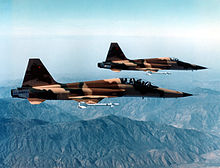
The VFC designation was created in 1988 when two Fleet Composite (VC) squadrons (VC-12 & 13) which were dedicated adversary squadrons were redesignated to differentiate them from the remaining VC squadrons which fulfilled various miscellaneous or utility roles. In 2006 a third VFC squadron (VFC-111) was established from what had become a permanent detachment of VFC-13 and in 2022 a fourth VFC squadron was created when the last remaining USNR VFA squadron (VFA-204) was redesignated to VFC. VFC squadrons provide adversary simulation for fleet squadrons. All VFC squadrons are Navy Reserve squadrons.
Two of the squadrons are based at NAS Fallon and NAS Key West to support fleet VFA squadron training at the extensive range complexes supported by those air stations. A third is based at NAS Oceana to support Strike Fighter Wing Atlantic squadron training and the fourth is based at NAS JRB New Orleans.
Note: The parenthetical (2nd) and (3rd) appended to some designations in the lineage column of table below are not a part of the squadron designation system. They are added to indicate that the designation was used more than once during the history of U.S. Naval Aviation and which use of the designation is indicated. Absence indicates that the designation was used only once.
| Squadron Designation | Insignia | Nickname | Aircraft | Operational and Administrative Commander | Squadron Lineage[5] | Notes |
|---|---|---|---|---|---|---|
| VFC-12 |  |
Fighting Omars | F/A-18E/F | Commander, Tactical Support Wing | VC-12(3nd): 1 Sep 1973-22 Apr 1988 VFC-12: 22 Apr 1988–present |
U S Navy Reserve Squadron Based at NAS Oceana |
| VFC-13 |  |
Saints | F-16C | Commander, Tactical Support Wing | VC-13(2nd): 1 Sep 1973-22 Apr 1988 VFC-13: 22 Apr 1988–present |
U S Navy Reserve Squadron Based at NAS Fallon |
| VFC-111 |  |
Sundowners | F-5F F-5N |
Commander, Tactical Support Wing | VFC-111: 1 Nov 2006–present | U S Navy Reserve Squadron Third "Sundowners" squadron Based at NAS Key West Adopted nickname and insignia of VF-111(3rd) which had been disestablished in 1995 |
| VFC-204 |  |
River Rattlers | F-5F F-5N |
Commander, Tactical Support Wing | VA-204: 1 Jul 1970-1991 Apr 1988 VFA-204: 1 May 1991–Oct 2022 VFC-204: Oct 2022–present |
US Navy Reserve Squadron Based at NAS JRB New Orleans |
Patrol and Reconnaissance (VP), Special Projects (VPU), Unmanned Patrol (VUP)
[edit]
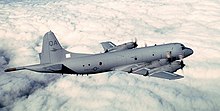
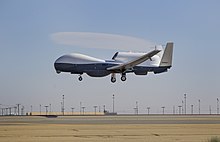
The VP designation is one of the oldest in the U. S. Navy and is the oldest designation currently in use. It first appeared in 1922 to designate "Seaplane Patrol Squadron" and from 1924 it has designated "Patrol Squadron".[4] In 1982 the VPU Patrol Squadron Special Unit designation was created.[4] Maritime patrol aircraft are used primarily for reconnaissance, anti-surface warfare and anti-submarine warfare. Volume 2 of the Dictionary of American Naval Aviation Squadrons contains comprehensive histories over 150 patrol squadrons. Its Appendix 7 details the lineage of every VP, VPB, VP(H), and VP(AM) squadron from 1922 through the late 1990s.
In 2016 the first "unmanned" Patrol Squadron (VUP) was established. VUP-19 operates the MQ-4C Triton unmanned air vehicle from an operations center located at NAS Jacksonville while its aircraft with aircraft maintenance personnel are deployed around the world as required. A second VUP squadron is programmed for establishment in the future with an operations center at NAS Whidbey Island.
When not deployed VP squadrons are home-ported at NAS Jacksonville, FL or NAS Whidbey Island, WA.
Note: The parenthetical (1st), (2nd), (3rd) and (First use), (Second use) etc... appended to some designations in the table below are not part of the squadron designation system. They are added to indicate that the designation was used more than once during the history of U.S. Naval Aviation and which use of the designation is indicated. Absence indicates that the designation was used only once.
| Squadron designation | Insignia | Nickname | Aircraft | Operational and administrative commander | Squadron lineage[5] | Notes |
|---|---|---|---|---|---|---|
| VP-1 (Fifth use) |
Screaming Eagles | P-8A | Commander, Patrol and Reconnaissance Wing TEN | VB-128: 15 Feb 1943-1 Oct 1944 VPB-128: 1 Oct 1944–15 May 1946 VP-128: 15 May 1946–15 Nov 1946 VP-ML-1: 15 Nov 1946-1 Sep 1948 VP-1(5th): 1 Sep 1948–present |
Homeport NAS Whidbey Island | |
| VP-4 (Second use) |
 |
Skinny Dragons | P-8A | Commander, Patrol and Reconnaissance Wing TEN | VB-144: 1 Jul 1943-1 Oct 1944 VPB-144: 1 Oct 1944–15 May 1946 VP-144: 15 May 1946–15 Nov 1946 VP-ML-4: 15 Nov 1946-1 Sep 1948 VP-4(2nd): 1 Sep 1948–present |
Homeport NAS Whidbey Island |
| VP-5 (Second use) |
 |
Mad Foxes | P-8A | Commander, Patrol and Reconnaissance Wing Eleven | VP-17F: 2 Jan 1937-1 Oct 1937 VP-17(1st): 1 Oct 1937-1 Jul 1939 VP-42(1st): 1 Jul 1939–15 Feb 1943 VB-135: 15 Feb 1943-1 Oct 1944 VPB-135: 1 Oct 1944–15 May 1946 VP-135: 15 May 1946–15 Nov 1946 VP-ML-5: 15 Nov 1946-1 Sep 1948 VP-5(2nd): 1 Sep 1948–present |
Homeport NAS Jacksonville |
| VP-8 (Second use) |
 |
Tigers | P-8A | Commander, Patrol and Reconnaissance Wing Eleven | VP-201: 1 Sep 1942-1 Oct 1944 VPB-201: 1 Oct 1944–15 May 1946 VP-201: 15 May 1946–15 Nov 1946 VP-MS-1: 15 Nov 1946-5 Jun 1947 VP-ML-8: 5 Jun 1947-1 Sep 1948 VP-8(2nd): 1 Sep 1948–present |
Homeport NAS Jacksonville |
| VP-9 (Second use) |
 |
Golden Eagles | P-8A | Commander, Patrol and Reconnaissance Wing TEN | VP-9(2nd): 15 Mar 1951–present | Homeport NAS Whidbey Island |
| VP-10 (Third use) |
 |
Red Lancers | P-8A | Commander, Patrol and Reconnaissance Wing Eleven | VP-10(3rd): 19 Mar 1951–present | Homeport NAS Jacksonville |
| VP-16 (Third use) |
 |
War Eagles | P-8A | Commander, Patrol and Reconnaissance Wing Eleven | VP-906: May 1946-15 Nov 1946 VP-ML-56: 15 Nov 1946-Feb 1950 VP-741: Feb 1959-4 Feb 1953: VP-16(3rd): 4 Feb 1953–present[14] |
Homeport NAS Jacksonville USNR VP-741 activated on 1 May 1951 for the Korean War |
| VP-26 (Third use) |
 |
Tridents | P-8A | Commander, Patrol and Reconnaissance Wing Eleven | VB-114: 26 Aug 1943-1 Oct 1944 VPB-114: 1 Oct 1944–15 May 1946 VP-114: 15 May 1946–15 Nov 1946 VP-HL-6: 15 Nov 1946-1 Sep 1948 VP-26(3rd): 1 Sep 1948–present |
Homeport NAS Jacksonville |
| VP-30 |  |
Pro's Nest | P-3C P-8A |
Commander, Patrol and Reconnaissance Group | VP-30: 30 Jun 1960–present | Fleet Replacement Squadron based at NAS Jacksonville |
| VP-40 (Second use) |
 |
Fighting Marlins | P-8A | Commander, Patrol and Reconnaissance Wing TEN | VP-40(2nd): 20 Jan 1951–present | Homeport NAS Whidbey Island |
| VP-45 (Third use) |
 |
Pelicans | P-8A | Commander, Patrol and Reconnaissance Wing Eleven | VP-205(1st): 1 Nov 1942-1 Oct 1944 VPB-205: 1 Oct 1944–15 May 1946 VP-205(2nd): 15 May 1946–15 Nov 1946 VP-MS-5: 15 Nov 1946-1 Sep 1948 VP-45(3rd): 1 Sep 1948–present |
Homeport NAS Jacksonville |
| VP-46 |  |
Grey Knights | P-8A | Commander, Patrol and Reconnaissance Wing TEN | VP-5S: 1 Sep 1931-1 Apr 1933 VP-5F: 1 Apr 1933–1937 VP-5(1st): 1937-1 Jul 1939 VP-33(1st): 1 Jul 1939-1 Jul 1941 VP-32(2nd): 1 Jul 1941-1 Oct 1944 VPB-32: 1 Oct 1944–15 May 1946 VP-MS-6: 15 Nov 1946-1 Sep 1948 VP-46: 1 Sep 1948-present |
Homeport NAS Whidbey Island Second oldest currently active aircraft squadron in the U. S. Navy |
| VP-47 |  |
Golden Swordsmen | P-8A | Commander, Patrol and Reconnaissance Wing TEN | VP-27(1st): 1 Jun 1944-1 Oct 1944 VPB-27: 1 Oct 1944–15 May 1946 VP-27(2nd): 15 May 1946–15 Nov 1946 VP-MS-7: 15 Nov 1946-1 Sep 1948 VP-47: 1 Sep 1948–present |
Homeport NAS Whidbey Island |
| VP-62 (Fourth use) |
 |
Broadarrows | P-8A | Commander, Maritime Support Wing | VP-62(4th): 1 Nov 1970–present | U S Navy Reserve Squadron Homeport NAS Jacksonville |
| VP-69 |  |
Totems | P-8A | Commander, Maritime Support Wing | VP-69: 1 Nov 1970–present | U S Navy Reserve Squadron Homeport NAS Whidbey Island |
| VPU-2 |  |
Wizards | P-8A | Commander, Patrol and Reconnaissance Wing Eleven | VPU-2: 1 Jul 1982–present | Homeport NAS Jacksonville |
| VUP-11 |  |
Proud Pegasus | MQ-4C | Commander, Patrol and Reconnaissance Wing TEN | To be established in 2025 and homeported at NAS Whidbey Island | |
| VUP-19 |  |
Big Red | MQ-4C | Commander, Patrol and Reconnaissance Wing Eleven | VUP-19: 1 Oct 2016[15][16]-present | Homeport NAS Jacksonville NAS Point Mugu (detachment) |
Fleet Air Reconnaissance (VQ)
[edit]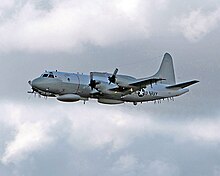
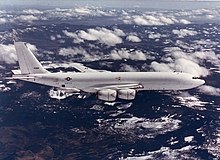
The VQ designation was created in 1955 to designate "Electronic Countermeasures Squadron" and did so though 1959. By 1960 the VQ squadrons, rather than simply jamming communications and electronic signals, had been equipped to collect them for intelligence purposes. In January 1960 this new role of the VQ squadrons was recognized by changing the VQ designation from "Electronic Countermeasures Squadron" to "Fleet Air Reconnaissance Squadron."[17] Fleet Air Reconnaissance Squadron ONE is currently the Navy's only overt signals intelligence (SIGINT) and communications intelligence (COMINT) reconnaissance squadron. The 13 EP-3E aircraft in the Navy's inventory are based on the Orion P-3 airframe and provide fleet and theater commanders worldwide with near real-time tactical SIGINT and COMINT. With sensitive receivers and high-gain dish antennas, the EP-3E exploits a wide range of electronic emissions from deep within targeted territory.
Fleet Air Reconnaissance Squadrons THREE and FOUR carry the VQ designation, but they are not reconnaissance squadrons; they are airborne command and control, and communications relay squadrons which provide survivable, reliable, and endurable airborne command, control, and communications between the National Command Authority (NCA) and U.S. strategic and non-strategic forces. The squadrons' E-6B aircraft are dual-mission aircraft, capable of fulfilling both the airborne strategic command post mission equipped with an airborne launch control system (ALCS) which is capable of launching U.S. land based intercontinental ballistic missiles[18] and fulfilling the TACAMO ("Take Charge and Move Out") mission which links the NCA with Navy ballistic missile submarine forces during times of crisis. The aircraft carries a very low frequency communication system with dual trailing wire antennae for that communications relay mission.
Fleet Air Reconnaissance Squadron SEVEN is the E-6B Fleet Replacement Squadron, providing initial and requalification training for pilots, aircrewmen, and maintainers. It operates E-6Bs on loan from VQ-3 and VQ-4, having returned a 737-600 it had previously operated on lease from Lauda Air.
| Squadron Designation | Insignia | Nickname | Aircraft | Operational Commander | Administrative Commander | Squadron Lineage[5] | Notes |
|---|---|---|---|---|---|---|---|
| VQ-1 |  |
World Watchers | EP-3E | Commander, Patrol and Reconnaissance Wing TEN | Commander, Patrol and Reconnaissance Wing TEN | VQ-1: 1 Jun 1955–present | Homeport NAS Whidbey Island |
| VQ-3 |  |
Ironman | E-6B | Commander, United States Strategic Command task force 124[b] | Commander, Strategic Communications Wing ONE | VQ-3: 1 Jul 1968–present | Homeport Tinker AFB Dets at Travis AFB and Offutt AFB |
| VQ-4 |  |
Shadows | E-6B | Commander, United States Strategic Command task force 124[b] | Commander, Strategic Communications Wing ONE | VQ-4: 1 Jul 1968–present | Homeport Tinker AFB Det at NAS Patuxent River |
| VQ-7 |  |
Roughnecks | E-6B | Commander, Strategic Communications Wing ONE | Commander, Strategic Communications Wing ONE | Naval Training Support Unit: 1992-1 Nov 1999 VQ-7: 1 Nov 1999–present |
Fleet Replacement Squadron based at Tinker AFB |
Fleet Logistics Support (VR)
[edit]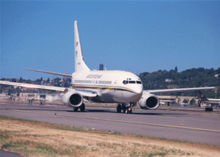
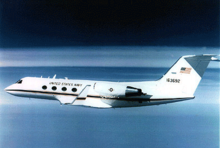

The VR designator was first established in 1942 to designated "Transport" or "Air Transport" or "Fleet Logistic Air" squadrons. From 1958 to 1976, it designated "Fleet Tactical Support Squadron"; from 1976 to the present, it designates "Fleet Logistics Support Squadron". Today, all Fleet Logistics Support squadrons are U.S. Navy Reserve squadrons
Fleet Logistics Support Squadrons operate Navy Unique Fleet Essential Airlift (NUFEA) aircraft on a worldwide basis to provide responsive, flexible, and rapidly deployable air logistics support required to sustain combat operations from the sea. During peacetime, squadrons provide air logistics support for all Navy commands as well as provide continuous quality training for mobilization readiness. Fleet Logistics Support squadrons have no counterpart in the Regular Navy. They represent 100% of the Navy's medium and heavy intra-theater airlift, and operate year-round around the world, providing the critical link between deployed seagoing units and air mobility command logistics hubs. VR-1 provides dedicated airlift support to the Office of the Secretary of the Navy, Chief of Naval Operations and Commandant of the Marine Corps.
The Headquarters of the Fleet Logistics Support Wing is based at Naval Air Station Joint Reserve Base Fort Worth, TX, but the squadrons of the wing are based across the country from the east coast to Hawaii. In addition to the VR squadrons, the Fleet Logistics Support Wing also operates two "Executive Transport Detachments" based in Hawaii and Sigonella, Italy.
Note: The parenthetical (2nd), (3rd), or (second use), (third use), etc., appended to some designations in the table below are not part of the squadron designation system. They are added to indicate that the designation was used more than once during the history of U.S. Naval Aviation and which use of the designation is indicated. Absence indicates that the designation was used only once.
| Squadron designation | Insignia | Nickname | Aircraft | Operational and administrative commander | Squadron lineage[5] | Notes |
|---|---|---|---|---|---|---|
| VR-1 (third use) |
 |
Star Lifters | C-37B | Commander, Fleet Logistics Support Wing | VR-1(3rd): 1 May 1997—present | U.S. Navy Reserve squadron Joint Base Andrews |
| VR-51 (second use) |
 |
Windjammers | C-40A | VR-51(2nd): 1 Jun 1997—present | U.S. Navy Reserve squadron MCAS Kaneohe Bay | |
| VR-53 |  |
Capital Express | C-130T | VR-53: 1 Oct 1992—present | U.S. Navy Reserve squadron Naval Air Facility Washington | |
| VR-54 (second use) |
 |
Revelers | C-130T | VR-54 (1st): 1 Oct 1972— 28 Feb 1981 VR-54 (2nd): 1 Jun 1991—present |
U.S. Navy Reserve squadron NAS JRB New Orleans | |
| VR-55 |  |
Minutemen | C-130T | VR-55: 1 Apr 1976—present | U.S. Navy Reserve squadron NAS Point Mugu | |
| VR-56 |  |
Globemasters | C-40A | VR-56: 1 Jul 1976—present | U.S. Navy Reserve squadron NAS Oceana | |
| VR-57 |  |
Conquistadors | C-40A | VR-57: 1 Nov 1977—present | U.S. Navy Reserve squadron NAS North Island | |
| VR-58 |  |
Sunseekers | C-40A | VR-58: 1 Nov 1977—present | U.S. Navy Reserve squadron NAS Jacksonville | |
| VR-59 |  |
Lone Star Express | C-40A | VR-59: 1 Oct 1982—present | U.S. Navy Reserve squadron NAS JRB Fort Worth | |
| VR-61 |  |
Islanders | C-40A | VR-61: 1 Oct 1982—present | U.S. Navy Reserve squadron NAS Whidbey Island | |
| VR-62 |  |
Nomads | C-130T | VR-62: 1 Jul 1985—present | U.S. Navy Reserve squadron NAS Jacksonville (relocated from NAS Brunswick in 2009) | |
| VR-64 |  |
Condors | C-130T | VP-64: 1 Nov 1970-18 Sep 2004 VR-64: 18 Sep 2004—present |
U.S. Navy Reserve squadron Joint Base McGuire, Dix, Lakehurst (relocated from NAS Willow Grove in Mar 2011) |
Fleet Logistics Support (VRC)
[edit]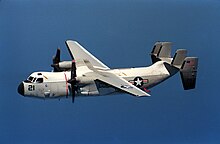
The VRC designation was established in 1960 to designate "Fleet Tactical Support Squadron". In 1976 the designation was changed to "Fleet Logistics Support Squadron."
There are two Fleet Logistic Support squadrons equipped with the C-2A Greyhound Carrier Onboard Delivery (COD) aircraft – one on each coast. VRC-30 is based at Naval Air Station North Island, VRC-40 is based at Naval Station Norfolk. These squadrons send two-plane detachments with each deploying Carrier Air Wing. The C-2A Greyhound, more commonly referred to as a "COD" (short for Carrier onboard delivery), is used to deliver high priority parts, supplies, people, and mail to/from the carrier and shore sites near the carrier operating area.
The E-2 Hawkeye and C-2 Greyhound are built on the same airframe and have many similar characteristics. For this reason, both aircraft are trained for in the same Fleet Replacement Squadron, VAW-120 (see VAW section).
| Squadron Designation | Insignia | Nickname | Aircraft | Operational Commander | Administrative Commander | Squadron Lineage[5] | Notes |
|---|---|---|---|---|---|---|---|
| VRC-30 |  |
Providers | Grumman C-2A Greyhound | Commander, Airborne Command, Control, Logistics Wing | Commander, Airborne Command, Control, Logistics Wing | VR-30: 1 Oct 1966-1 Oct 1978 VRC-30: 1 Oct 1978–2023 |
Homeport NAS North Island |
| VRC-30 Det 1 |  |
Hustlers | C-2A | Commander, Carrier Air Wing Seventeen | Commanding Officer, Fleet Logistics Support Squadron Thirty | Homeport NAS North Island | |
| VRC-30 Det 2 |  |
Roughnecks | C-2A | Commander, Carrier Air Wing Two | Commanding Officer, Fleet Logistics Support Squadron Thirty | ||
| VRC-30 Det 3 |  |
Crusaders | C-2A | Commander, Carrier Air Wing Eleven | Commanding Officer, Fleet Logistics Support Squadron Thirty | ||
| VRC-30 Det 4 |  |
Pure Horsepower | C-2A | Commander, Carrier Air Wing Nine | Commanding Officer, Fleet Logistics Support Squadron Thirty | ||
| VRC-30 Det 5 |  |
Providers | C-2A | Commander, Carrier Air Wing Five | Commanding Officer, Fleet Logistics Support Squadron Thirty | Forward deployed to MCAS Iwakuni, Japan |
| Squadron Designation | Insignia | Nickname | Aircraft | Operational Commander | Administrative Commander | Squadron Lineage[5] | Notes |
|---|---|---|---|---|---|---|---|
| VRC-40 |  |
Rawhides | C-2A | Commander, Airborne Command, Control, Logistics Wing | Commander, Airborne Command, Control, Logistics Wing | VRC-40: 1 Jul 1960–present | Homeport NS Norfolk |
| VRC-40 Det 2 | Rawhides | C-2A | Commander, Carrier Air Wing O | Commanding Officer, Fleet Logistics Support Squadron Forty | |||
| VRC-40 Det 3 | Rawhides | C-2A | Commander, Carrier Air Wing Seven | ||||
| VRC-40 Det 4 | Rawhides | C-2A | Commander, Carrier Air Wing Three | ||||
| VRC-40 Det 5 | Rawhides | C-2A | Commander, Carrier Air Wing EIGHT |
Fleet Logistics Multi-Mission (VRM)
[edit]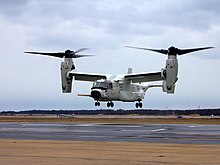
"The Bell Boeing CMV-22B Osprey long-range tiltrotor aircraft is the US Navy’s future variant of MV-22B Osprey assault support aircraft developed for the US Marine Corps. The medium-lift variant will operate as a carrier on-board delivery (COD) aircraft to meet the logistics support requirements of the Joint Force Maritime Component Commander (JFMCC) during time-critical scenarios. It will replace Northrop Grumman-built C-2A Greyhound cargo aircraft that has been in service with the US Navy since the 1960s. The CMV-22B will be used by the US Navy for transportation of special warfare teams, mail and cargo from shore to its aircraft carriers, as well as for shore or sea-based combat search-and-rescue (CSAR) missions".[19]
The development of the VRM designation and adoption of the CMV-22B demonstrates the Navy's intent to utilize the platform as a means of replacing the carrier-based C-2A Greyhound. This shift in direction has coincided with the formation of the Navy's first VRM squadron, the "Titans" of VRM-30 (The name of which was revived from the "Titans" of HSL-94).[20]
| Squadron Designation | Insignia | Nickname | Aircraft | Operational commander | Administrative commander[21] | Squadron Lineage[22] | Notes[20] |
|---|---|---|---|---|---|---|---|
| VRM-30 |  |
Titans | CMV-22B | Fleet Logistics Multi-Mission Wing (COMVRMWING) | Fleet Logistics Multi-Mission Wing (COMVRMWING) | VRM-30: 1 Dec 2018 – present | Homeport NAS North Island |
| VRM-40 |  |
Mighty Bison | CMV-22B | Fleet Logistics Multi-Mission Wing (COMVRMWING) | Fleet Logistics Multi-Mission Wing (COMVRMWING) | VRM-40: 14 March 2022 – present | Homeport NS Norfolk |
| VRM-50 |  |
Sunhawks | CMV-22B | Fleet Logistics Multi-Mission Wing (COMVRMWING) | Fleet Logistics Multi-Mission Wing (COMVRMWING) | VRM-50: 1 Oct 2019 – present[23] | Fleet Replacement Squadron based at NAS North Island |
Training (VT)
[edit]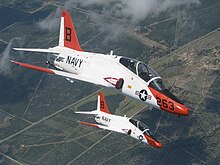

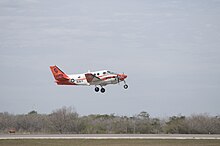
The VT designation was one of the original designations. It was established in 1921 to designate "Torpedo Plane Squadron". From 1922 to 1930 it designated "Torpedo & Bombing Squadron" and from 1930 to 1946 "Torpedo Squadron".[4] In 1946 all remaining Torpedo Squadrons and Bombing Squadrons (VB) were redesignated "Attack Squadrons" (VA) and the VT designation was retired.[24]
From 1927 to 1947 training squadrons were designated "VN".[4] From 1947 to 1960 training units were not designated as squadrons, they were "units" or "groups" called Basic Training Groups (BTG), Advanced Training Units (ATU), Jet Transition Training Units (JTTU) or Multi Engine Training Groups (METG). On 1 May 1960 the VT designation was resurrected and existing flying training units were designated "Training Squadrons (VT)".[4]
There are two types of fixed wing training squadrons: Primary training squadrons train students in the first stage of flight training leading to selection to one of three advanced training pipelines for Aviators (Rotary Wing, Strike or Multi-Engine) or two advanced training pipelines for Flight Officers (Multi Crew or Strike). The advanced training squadrons conduct the final stage of flight training leading to "winging" of the new Naval Aviators and Naval Flight Officers in the Navy, Marine Corps, and Coast Guard. Training squadrons are organized differently than the Navy's operational squadrons as training squadrons do not own their own aircraft. All training aircraft are assigned to and maintained by the Training Air Wing to which the squadrons are assigned. The training squadrons are composed only of Instructors and Students, with all maintenance and support functions carried out by the Training Air Wing. Training aircraft are painted orange and white.
| Squadron Designation | Insignia | Nickname | Aircraft | Operational and Administrative Commander | Squadron Lineage[5] | Notes |
|---|---|---|---|---|---|---|
| VT-2 |  |
Doerbirds | T-6B | Commander, Training Air Wing Five | BTG-2: ??-1 May 1960 VT-2: 1 May 1960-present |
Primary Training, based at NAS Whiting Field |
| VT-3 |  |
Red Knights | T-6B | Commander, Training Air Wing Five | BTG-3: ??-1 May 1960 VT-3: 1 May 1960-present |
Primary Training, based at NAS Whiting Field |
| VT-4 |  |
Warbucks | Multi-Crew Simulator | Commander, Training Air Wing Six | BTG-9: ??-1 May 1960: VT-4: 1 May 1960-present (inactive Dec 2010-Jun 2013) |
NFO Advanced Training, based at NAS Pensacola Deactivated in Dec 2010 as an NFO primary training squadron and reactivated[1] as an NFO advanced training squadron in Jun 2013 |
| VT-6 |  |
Shooters | T-6B | Commander, Training Air Wing Five | METG Whiting Field: 1 Jul 1956-1 May 1960 VT-6: 1 May 1960 – present |
Primary Training, based at NAS Whiting Field |
| VT-7 |  |
Eagles | T-45C | Commander, Training Air Wing One | BTG-7: 1 Jun 1958-1 May 1960 VT-7: 1 May 1960 – present |
Advanced Training, based at NAS Meridian |
| VT-9 (Second training sqdn use) |
 |
Tigers | T-45C | Commander, Training Air Wing One | VT-19: 2 Aug 1971-1 Oct 1998 VT-9(2nd): 1 Oct 1998–present |
Advanced Training, based at NAS Meridian (There was an earlier training squadron designated VT-9 also called "Tigers" which existed from 15 Dec 1961 to Jul 1987) |
| VT-10 |  |
Wildcats | T-6A | Commander, Training Air Wing Six | BNAO School*: Jun 1960-15 Jan 1968 VT-10: 15 Jan 1968–present |
*Basic Naval Aviation Officer School NFO Primary Training, based at NAS Pensacola |
| VT-21 |  |
Redhawks | T-45C | Commander, Training Air Wing Two | ATU-202: Apr 1951-1 May 1960 VT-21: 1 May 1960 – present |
Advanced Training, based at NAS Kingsville |
| VT-22 |  |
Golden Eagles | T-45C | Commander, Training Air Wing Two | ATU-6: 13 Jun 1949-?? JTTU-1: ??-?? ATU-3: ??-?? ATU-212: ??-1 May 1960 VT-22: 1 May 1960-present |
Advanced Training, based at NAS Kingsville |
| VT-27 |  |
Boomers | T-6B | Commander, Training Air Wing Four | ATU-B: 11 Jul 1951-?? ATU-402: ??-1 Jul 1960 VT-27: 1 Jul 1960-present |
Primary Training, based at NAS Corpus Christi |
| VT-28 |  |
Rangers | T-6B | Commander, Training Air Wing Four | ATU-611: ??-1 May 1960 VT-28: 1 May 1960-present |
Primary Training, based at NAS Corpus Christi |
| VT-31 |  |
Wise Owls | T-44C | Commander, Training Air Wing Four | ATU-601: Feb 1958-1 May 1960 VT-31: 1 May 1960 – present |
Advanced Training, based at NAS Corpus Christi |
| VT-35 |  |
Stingrays | T-44C | Commander, Training Air Wing Four | VT-35: 29 Oct 1999–present | Advanced Training, based at NAS Corpus Christi |
| VT-86 |  |
Sabrehawks | T-45C | Commander, Training Air Wing Six | VT-86: 5 Jun 1972–present | NFO Advanced Training, based at NAS Pensacola |
Air Test and Evaluation (VX), Scientific Development (VXS)
[edit]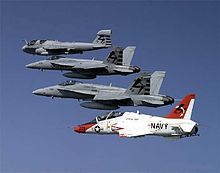
The VX designation was first used from 1927 to 1943 to designate "Experimental Squadron". It was again used beginning in 1946 when four "Experimental and Development" squadrons (VX-1 (still exists today), 2, 3 and 4)[25] were established to develop and evaluate new equipment and methods. From 1946 to 1968 the designation was variously "Experimental and Development" squadron, "Operational Development" squadron, "Air Operational Development" squadron and "Air Development" squadron. In 1969 the designation changed to "Air Test and Evaluation" and it remains as such today.[4]
Test and Evaluation squadrons test everything from basic aircraft flying qualities to advanced aerodynamics to weapons systems effectiveness. VX-20, VX-23, VX-30, VX-31 (as well as HX-21 (rotary wing squadron) and UX-24 (UAS squadron)) are developmental test and evaluation squadrons which conduct or support developmental test and evaluation of aircraft and weapons as part of the Naval Air Systems Command (NAVAIRSYSCOM) while VX-1 and VX-9 are operational test and evaluation squadrons which conduct operational test and evaluation of aircraft and weapons as part of the Operational Test and Evaluation Force (OPTEVFOR).
| Squadron Designation | Insignia | Nickname | Aircraft | Operational and Administrative Commander | Squadron Lineage[5] | Notes |
|---|---|---|---|---|---|---|
| VX-1 |  |
Pioneers | P-3C MH-60R MH-60S SH-60F EP-3E E-6B KC-130J E-2D RQ-4 P-8A |
Commander, Operational Test and Evaluation Force | Acft ASW Dev Det Atlantic Flt: 1 Apr 1943-17 Sep 1943 ASW Dev Det Atlantic Flt: 17 Sep 1943–15 Mar 1946 VX-1: 15 Mar 1946–present |
Operational test and evaluation of ASW and other "maritime" aircraft and weapons. Based at NAS Patuxent River[26] |
| VX-9 |  |
Vampires | F/A-18A/B/C/D/E/F F-35B/C EA-18G |
Commander, Operational Test and Evaluation Force | VX-9: 30 Apr 1994–present | Operational test and evaluation of strike aircraft and weapons. Based at NAWS China Lake Established from the assets of VX-4(2nd) "Evaluators" and VX-5 "Vampires" which were both disestablished in 1994 |
| VX-20 |  |
Force | E-2D P-8A C-130T C-130J C-2A E-6B |
Commander, Naval Test Wing Atlantic | Naval Force Acft Test Sqdn: 21 Jul 1955-1 May 2002 VX-20: 1 May 2002 |
Developmental test and evaluation of ASW and other maritime aircraft. NAS Patuxent River[27] |
| VX-23 |  |
Salty Dogs | F-35B/C F/A-18A/B/C/D/E/F EA-6B EA-18G T-45 |
Commander, Naval Test Wing Atlantic | Naval Strike Acft Test Sqdn: 21 Jul 1995-1 May 2002 VX-23: 1 May 2001 – present |
Developmental test and evaluation of Strike Aircraft. NAS Patuxent River |
| UX-24 |  |
Ghost Wolves | MQ-8 RQ-20 RQ-21 RQ-26 |
Commander, Naval Test Wing Atlantic | UX-24: 18 October 2018 – present | Developmental test and evaluation of unmanned aircraft. NAS Patuxent River[28] |
| VX-30 |  |
Bloodhounds | C-130 P-3 NP-3D KC-130T UAVs |
Commander, Naval Test Wing Pacific | Naval Weapons Test Sqdn, Pt Mugu: 8 May 1995 – 1 May 2002 VX-30: 1 May 2002 – present |
Range surveillance, photometric support, area clearance, and airborne telemetry on the Naval Air Systems Command Sea Test Range in support of developmental test and evaluation of airborne weapons and platform-related systems. Based at NAS Point Mugu |
| VX-31 |  |
Dust Devils | F/A-18A/B/C/D/E/F EA-18G NEA-18G P-3 C-130 AV-8B TAV-8B T-39 MH-60S AH-1Z UH-1Y and other variants |
Commander, Naval Test Wing Pacific | Naval Weapons Test Sqdn, China Lake: 8 May 1995 – 1 May 2002 VX-31: 1 May 2002 – present |
Developmental test and evaluation of airborne weapons and platform-related systems. Based at NAWS China Lake |
| VXS-1 |  |
Warlocks | NP-3D P-3C UV-18A RC-12M Tiger Shark UAS |
Commander, Naval Research Laboratory | VXS-1: 13 Dec 2004–present | NRL early scientific development and testing. Based at NAS Patuxent River[26] Formerly NRL's Flight detachment |
Other Fixed Wing Aircraft Units
[edit]
Other than the Naval Flight Demonstration Squadron (NFDS) "Blue Angels", the organizations in the table below are not technically "squadrons", however they either have custody of and routinely fly Navy aircraft or they routinely fly aircraft on loan from fleet squadrons for advanced training of those fleet squadrons.
The U.S. Naval Test Pilot School operates various fixed and rotary wing aircraft to train and graduate test pilots and test engineers.
The Navy Fighter Weapons School, Carrier Airborne Early Warning Weapons School and the Airborne Electronic Attack Weapons School train selected U. S. Navy Naval Aviators and Naval Flight Officers (NFO) in instructional techniques and in advanced tactics in their respective aircraft, qualifying them for assignment to their respective wing weapons schools (Strike Fighter Weapons School Lant and Pac, Electronic Attack Weapons School and Airborne Command Control and Logistics School) where they provide advanced training for each wing's squadrons utilizing squadron aircraft.
Rotary wing squadrons
[edit]US Navy rotary wing squadron designations start with the letter H. The first use of the letter H to designate a helicopter squadron was in 1948 with the establishment of Helicopter Utility Squadrons (HU)[4] One and Two. Before then, the two basic types of Navy squadrons were "heavier than air" squadrons designated with V and "lighter than air" squadrons designated with Z. By 1961 the Navy had disestablished its last lighter than air squadrons; since then V has in practicality become the designation for "fixed wing squadron" and H for "rotary wing squadron." The Navy today uses helicopters for antisubmarine warfare, antisurface warfare, mine countermeasures, combat search and rescue, special operations, overwater search and rescue, and vertical replenishment roles.
Helicopter Mine Countermeasures (HM)
[edit]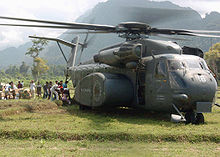
The HM designation was created in 1971 to designate "Helicopter Mine Countermeasures Squadron". HM Squadrons employ 28 total Sikorsky MH-53E Sea Dragon helicopters. The primary mission of the Sea Dragon is Airborne Mine Countermeasures (AMCM). The MH-53 can operate from aircraft carriers, large amphibious ships and the new expeditionary sea base and is capable of towing a variety of mine hunting/sweeping countermeasures systems.[29] The MH-53E Sea Dragon can also carry an impressive amount of cargo, equipment, or number of personnel over long distances. The Sea Dragon is the Navy's only heavy-lift helicopter and only proven mine countermeasure platform.
The Navy's recently completed "Helicopter Master Plan" was a plan to reduce the number of type/model/series from eight down to two (MH-60R and MH-60S). It recognized that the replacement of the MH-53 in the mine countermeasures role was dependent on technology which has not yet matured. As a result, the MH-53E continues in service as the only helicopter capable now and in the near future of effectively conducting airborne mine countermeasures.
Note: The parenthetical (second use) and (2nd) in the table below are not a part of the squadron designation system. They are added to indicate that the designation was used more than once during the history of U. S. Naval Aviation and which use of the designation is indicated.
| Squadron Designation | Insignia | Nickname | Aircraft | Operational and Administrative Commander | Squadron Lineage[5] | Notes |
|---|---|---|---|---|---|---|
| HM-12 (Second use) |
 |
Sea Dragons | MH-53E | Commander, Helicopter Sea Combat Wing Atlantic | HM-12(2nd): 1 Oct 2015–present | Fleet Replacement Squadron based at NS Norfolk (There was an earlier squadron designated HM-12 also called the "Sea Dragons" which existed from 1 Apr 1971 to 30 Sep 1994) |
| HM-14 |  |
Vanguard | MH-53E | Commander, Helicopter Sea Combat Wing Atlantic | HM-14: 12 May 1978 – 30 March 2023 [30] | Homeport NS Norfolk |
| HM-15 |  |
Blackhawks | MH-53E | Commander, Helicopter Sea Combat Wing Atlantic | HM-15: 2 Jan 1987–present | Homeport NS Norfolk |
Helicopter Sea Combat (HSC)
[edit]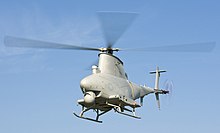

The Helicopter Sea Combat (HSC) Designation was created in 2005 after the Helicopter Combat Support (HC) squadrons equipped with the H-46 Sea Knight had completed their transitions to the new multi-mission MH-60S Seahawk, and in anticipation of the upcoming transition of the Helicopter Antisubmarine (HS) squadrons from the SH-60F and HH-60H Seahawks to the new MH-60S Knighthawk which began in 2007. The ASW capabilities resident in the HS squadrons were lost in the transition but the new HSC squadrons combine the at sea logistics capability of the former Helicopter Combat Support (HC) squadrons with greatly upgraded Combat Search and Rescue, Naval Special Warfare Support and Anti-Surface Warfare capabilities of the former Helicopter Anti-submarine squadrons (HS).[31]
The HSC squadrons, which were formerly HS squadrons, are carrier based and deploy as part of a Carrier Air Wing, while the HSC squadrons which were formerly HC squadrons or were newly established are land based "expeditionary" squadrons which supply detachments for deployment aboard ships other than aircraft carriers or for land based deployments as required. The squadrons are home-ported at NS Norfolk, NAS North Island and Anderson AFB, Guam with one squadron forward deployed to NAF Atsugi, Japan. Expeditionary HSC squadrons are capable of deploying mixed detachments of MH-60S and MQ-8B Fire Scout uncrewed aircraft.
Note: The parenthetical (2nd) used in the lineage column of table below is not a part of the squadron designation system. It is added to indicate that the designation was used more than once during the history of U. S. Naval Aviation and which use of the designation is indicated.
| Squadron Designation | Insignia | Nickname | Aircraft | Operational Commander | Squadron Lineage[5] | Notes |
|---|---|---|---|---|---|---|
| HSC-2 |  |
Fleet Angels | MH-60S | Commander, Helicopter Sea Combat Wing Atlantic | HC-2(2nd): 1 Apr 1987-24 Aug 2005 HSC-2: 24 Aug 2005–present |
Fleet Replacement Squadron based at NS Norfolk (There was an earlier squadron designated HC-2 also called "Fleet Angels" which existed from 1 Apr 1948 to 30 Sep 1977) |
| HSC-3 |  |
Merlins | MH-60S | Commander, Helicopter Sea Combat Wing Pacific | HC-3: 1 Sep 1967-31 Oct 2005 HSC-3: 31 Oct 2005–present |
Fleet Replacement Squadron based at NAS North Island |
| HSC-4 |  |
Black Knights | MH-60S | Commander, Carrier Air Wing Two | HS-4: 30 Jun 1952-Mar 2012 HSC-4: Mar 2012–present |
Homeport NAS North Island |
| HSC-5 |  |
Nightdippers | MH-60S | Commander, Carrier Air Wing SEVEN | HS-5: 3 Jan 1956 – 28 Feb 2009: HSC-5: 28 Feb 2009–present |
Homeport NS Norfolk |
| HSC-6 |  |
Indians | MH-60S | Commander, Carrier Air Wing Seventeen | HS-6: 1 Jun 1956-Jul 2011 HSC-6: Jul 2011–present |
Homeport NAS North Island |
| HSC-7 |  |
Dusty Dogs | MH-60S | Commander, Carrier Air Wing Three | HS-7(2nd): 15 Dec 1969-Apr 2011 HSC-7: Apr 2011–present |
Homeport NS Norfolk (There was an earlier squadron designated HS-7 called the "Big Dippers" which existed from 2 Apr 1956 to 31 May 1966) |
| HSC-8 |  |
Eightballers | MH-60S | Commander, Carrier Air Wing Eleven | HS-8(2nd): 1 Nov 1969-1 Apr 2007 HSC-8: 1 Apr 2007–present |
Homeport NAS North Island (There was an earlier squadron designated HS-8 also called "Eighballers" which existed from 1 Jun 1956 to 31 Dec 1968) |
| HSC-9 |  |
Tridents | MH-60S | Commander, Carrier Air Wing EIGHT | HS-3: 18 Jun 1952-1 Jun 2009 HSC-9: 1 Jun 2009–present |
Homeport NS Norfolk |
| HSC-11 |  |
Dragon Slayers | MH-60S | Commander, Carrier Air Wing ONE | HS-11: 27 Jun 1957-Jun 2016 HSC-11: Jun 2016–present |
Homeport NS Norfolk |
| HSC-12 |  |
Golden Falcons | MH-60S | Commander, Carrier Air Wing Five | HS-2: 7 Mar 1952-1 Jan 2009 HSC-12: 1 Jan 2009–present |
Forward deployed to NAF Atsugi Japan |
| HSC-14 |  |
Chargers | MH-60S | Commander, Carrier Air Wing Nine | HS-14: 19 Jul 1984-Jul 2013 HSC-14: Jul 2013–present |
Homeport NAS North Island |
| HSC-21 |  |
Blackjacks | MH-60S | Commander, Helicopter Sea Combat Wing Pacific | HC-11: 1 Oct 1977-7 Nov 2005 HSC-21: 7 Nov 2005–present |
Homeport NAS North Island Expeditionary Squadron |
| HSC-22 |  |
Sea Knights | MH-60S | Commander, Helicopter Sea Combat Wing Atlantic | HSC-22: 1 Oct 2006–present | Homeport NS Norfolk Expeditionary Squadron |
| HSC-23 |  |
Wildcards | MH-60S | Commander, Helicopter Sea Combat Wing Pacific | HSC-23: 1 Oct 2006–present | Homeport NAS North Island Expeditionary Squadron |
| HSC-25 |  |
Island Knights | MH-60S | Commander, Helicopter Sea Combat Wing Pacific | HC-5(2nd): 3 Feb 1984-24 Oct 2005 HSC 25: 24 Oct 2005–present |
Homeport Andersen AFB, Guam Expeditionary Squadron (There was an earlier squadron designated HC-5 called the "Arch Angels" which carried the HC-5 designation from 1 Sep 1967 to Mar 1972) |
| HSC-26 |  |
Chargers | MH-60S | Commander, Helicopter Sea Combat Wing Atlantic | HC-6: 1 Sep 1967-24 Aug 2005 HSC-26: 24 Aug 2005–present |
Homeport NS Norfolk Expeditionary Squadron |
| HSC-28 |  |
Dragon Whales | MH-60S | Commander, Helicopter Sea Combat Wing Atlantic | HC-8: 3 Dec 1984-13 May 2005 HSC-28: 13 May 2005 – present |
Homeport NS Norfolk Expeditionary Squadron |
| HSC-85 |  |
Firehawks | MH-60S | Commander, Maritime Support Wing | HS-85: 1 Jul 1970-1 Oct 1994 HC-85: 1 Oct 1994-8 Feb 2006 HSC-85: 8 Feb 2006–present |
U S Navy Reserve Squadron Naval Special Warfare Support Homeport NAS North Island Expeditionary Squadron (Adopted "Firehawks" name and insignia in 2011 from deactivated HCS-5) |
Helicopter Maritime Strike (HSM)
[edit]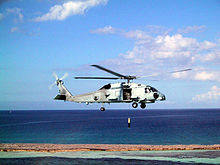

The HSM designation was created in 2006 when the Fleet Replacement Squadron for the MH-60R Seahawk was redesignated from HSL. The new designation was created to reflect the MH-60Rs multi-mission capabilities[32] which combined the area search capabilities of the SH-60B flown by the Helicopter Anti-Submarine Squadron Light (HSL) squadrons with the dipping sonar of the SH-60F flown by the carrier based Helicopter Anti-Submarine (HS) squadrons. The first operational fleet squadron to receive the MH-60 Romeo was HSM-71 in fiscal year 2008. With the transition of the HS squadrons to HSC squadrons without any ASW capability and the disestablishment of the last Air Antisubmarine (VS) squadrons, all ship based airborne ASW capabilities now reside in the new HSM squadrons.
From 2009 to 2015 all Helicopter Anti-Submarine Squadron Light (HSL) squadrons transitioned to the MH-60R and were redesignated Helicopter Maritime Strike (HSM) squadrons. Additionally, new HSM squadrons were established in order to provide an HSM squadron to each Carrier Air Wing and to provide "Expeditionary" squadrons to supply detachments of MH-60Rs to ships other than aircraft carriers. Expeditionary HSM squadrons are capable of deploying mixed detachments of MH-60R and MQ-8B aircraft.
HSM squadrons are home-ported at NAS North Island, NAS Jacksonville, NS Mayport and MCAS Kaneohe Bay with two squadrons forward deployed to NAF Atsugi Japan and one squadron forward deployed to Naval Station Rota Spain.
| Squadron | Insignia | Nickname | Aircraft | Operational commander | Squadron lineage[5] | Notes |
|---|---|---|---|---|---|---|
| HSM-35 |  |
Magicians | MH-60R MQ-8B |
Commander, Helicopter Maritime Strike Wing Pacific | HSM-35: 2 May 2013 – present[33] | Homeport NAS North Island Expeditionary Squadron (There was an earlier squadron designated HSL-35 also called "Magicians" which existed from 15 Jan 1974 to 4 Dec 1992) |
| HSM-37 |  |
Easyriders | MH-60R | Commander, Helicopter Maritime Strike Wing Pacific | HSL-37: 3 Jul 1975-1 Oct 2013 HSM-37: 1 Oct 2013–present |
Homeport MCAS Kanehoe Bay Expeditionary Squadron |
| HSM-40 |  |
Airwolves | MH-60R | Commander, Helicopter Maritime Strike Wing Atlantic | HSL-40: 4 Oct 1985-1 Nov 2009 HSM-40: 1 Nov 2009–present |
Fleet Replacement Squadron based at NS Mayport |
| HSM-41 |  |
Seahawks | MH-60R | Commander, Helicopter Maritime Strike Wing Pacific | HSL-41: 21 Jan 1983-8 Dec 2005 HSM-41: 8 Dec 2005–present |
Fleet Replacement Squadron based at NAS North Island |
| HSM-46 |  |
Grandmasters | MH-60R | Commander, Carrier Air Wing SEVEN | HSL-46: 7 Apr 1988–2012 HSM-46: 2012-present |
Homeport NAS Jacksonville |
| HSM-48 |  |
Vipers | MH-60R | Commander, Helicopter Maritime Strike Wing Atlantic | HSL-48: 7 Sep 1989-May 2014 HSM-48: May 2014 – present |
Homeport NS Mayport Expeditionary Squadron |
| HSM-49 |  |
Scorpions | MH-60R | Commander, Helicopter Maritime Strike Wing Pacific | HSL-49: 23 Mar 1990-Apr 2015 HSM-49: Apr 2015–present |
Homeport NAS North Island Expeditionary Squadron |
| HSM-50 |  |
Valkyries | MH-60R | Commander, Helicopter Maritime Strike Wing Atlantic | HSM-50: 1 October 2021–present | Homeport NS Mayport Expeditionary Squadron |
| HSM-51 |  |
Warlords | MH-60R | Commander, Helicopter Maritime Strike Wing Pacific | HSL-51: 1 Oct 1991-Mar 2013 HSM-51: Mar 2013–present |
Forward deployed to NAF Atsugi, Japan Expeditionary Squadron |
| HSM-60 |  |
Jaguars | MH-60R | Commander, Maritime Support Wing | HSL-60: 1 Apr 2001-Jul 2015 HSM-60: Jul 2015–present |
US Navy Reserve Squadron Homeport NAS Jacksonville Expeditionary Squadron |
| HSM-70 |  |
Spartans | MH-60R | Commander, Carrier Air Wing EIGHT | HSM-70: 1 Mar 2008–present | Homeport NAS Jacksonville |
| HSM-71 |  |
Raptors | MH-60R | Commander, Carrier Air Wing Nine | HSM-71: 1 Jan 2007–present | Homeport NAS North Island |
| HSM-72 |  |
Proud Warriors | MH-60R | Commander, Carrier Air Wing ONE | HSL-42: 5 Oct 1984-Jan 2013 HSM-72: Jan 2013–present |
Homeport NAS Jacksonville |
| HSM-73 |  |
Battle Cats | MH-60R | Commander, Carrier Air Wing Seventeen | HSL-43: 5 Oct 1984-Feb 2012 HSM-73: Feb 2012–present |
Homeport NAS North Island |
| HSM-74 |  |
Swamp Fox | MH-60R | Commander, Carrier Air Wing THREE | HSL-44: 21 Aug 1986-Jun 2011 HSM-74: Jun 2011–present |
Homeport NAS Jacksonville |
| HSM-75 |  |
Wolfpack | MH-60R | Commander, Carrier Air Wing Eleven | HSL-45: 3 Oct 1986-Feb 2011 HSM-75: Feb 2011–present |
Homeport NAS North Island |
| HSM-77 |  |
Saberhawks | MH-60R | Commander, Carrier Air Wing Five | HSL-47: 25 Sep 1987-1 Feb 2009 HSM-77: 1 Feb 2009–present |
Forward deployed to NAF Atsugi, Japan (HSL-47 was the only HSL (LAMPS) squadron to have deployed aboard a carrier as a test of the CVN based HSM squadron concept)[34] |
| HSM-78 |  |
Blue Hawks | MH-60R | Commander, Carrier Air Wing TWO | HSM-78: 1 Mar 2012–present | Homeport NAS North Island |
| HSM-79 |  |
Griffins | MH-60R | Commander, Helicopter Maritime Strike Wing Atlantic | HSM-79: 2 Jun 2016–present | Forward deployed to Naval Station Rota, Spain Expeditionary Squadron |
Helicopter Training (HT)
[edit]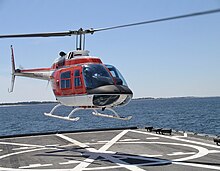
The HT designation first appeared in May 1960 to designate Helicopter Training Squadron at the same time that the VT designation was resurrected to designate Training Squadron. In the early years of helicopter operations in the Navy, helicopter pilots were qualified fixed wing pilots who received transition training once they reported to a helicopter squadron. In 1950 a dedicated helicopter training unit was established and in 1960 that unit became the first HT squadron. As the demand for helicopter pilots increased over the decades, additional HT squadrons were established and today approximately 60% of the Student Naval Aviators from all services (Navy, Marine Corps and Coast Guard) are winged as helicopter pilots.
The Naval Air Training Command's Helicopter Training Squadrons provide advanced helicopter flight instruction to all Navy, US Marine Corps, and United States Coast Guard helicopter flight students as well as to international students from several allied nations. Student Naval Aviators are selected for helicopter training after completion of primary flight training in the T-6B in one of the VT squadrons. Students who successfully complete the program earn the right to wear the coveted "Wings of Gold."[35] and proceed on to their selected aircraft's Fleet Replacement Squadron. Training squadrons are organized differently than the Navy's operational squadrons as training squadrons do not own their own aircraft. All training aircraft are assigned to and maintained by the Training Air Wing to which the squadrons are assigned. The training squadrons are composed only of Instructors and Students, with all maintenance and support functions carried out by the Training Air Wing.
| Squadron | Insignia | Nickname | Aircraft | Operational and administrative Commander | Squadron lineage[5] | Notes |
|---|---|---|---|---|---|---|
| HT-8 |  |
Eightballers | TH-73A | Commander,
Training Air Wing Five, Naval Air Training Comman |
HTU-1: 3 Dec 1950 HTG-1: Mar 1957 HT-8: 1 Jul 1960–present |
Advanced training based at NAS Whiting Field |
| HT-18 |  |
Vigilant Eagles | TH-57B TH-57C TH-73A |
HT-18: 1 Mar 1972–present | ||
| HT-28 |  |
Hellions | TH-57B TH-57C |
HT-28: 1 Nov 2006–present |
Air Test and Evaluation (HX)
[edit]Test and Evaluation squadrons test everything from basic aircraft flying qualities to advanced aerodynamics to weapons systems effectiveness. HX-21 conducts developmental test and evaluation of rotary wing and tilt rotor aircraft and weapons as part of the Naval Air Systems Command (NAVAIRSYSCOM).
| Squadron Designation | Insignia | Nickname | Aircraft | Operational and Administrative Commander | Squadron Lineage[5] | Notes |
|---|---|---|---|---|---|---|
| HX-21 |  |
Blackjack | AH-1Z UH-1Y MH-60R MH-60S MV-22B AH-1W UH-1N VH-3A CH-53E |
Commander, Naval Test Wing Atlantic | Naval Rotary Wing Acft Test Sqdn: 21 Jul 1995-1 May 2002 HX-21: 1 May 2002 – present |
Developmental test and evaluation of Rotary Wing and Tilt Rotor Aircraft NAS Patuxent River[36] |
Other Rotary Wing Aircraft Units
[edit]The organizations in the table below are not technically "squadrons", however they either have custody of and routinely fly Navy aircraft or they routinely fly aircraft on loan from fleet squadrons for advanced training of those fleet squadrons. The Navy Rotary Wing Weapons School trains selected U. S. Navy Naval Aviators in instructional techniques and in advanced tactics for their respective aircraft, qualifying them for assignment to their respective wing weapons schools (Helicopter Sea Combat Weapons School Lant and Pac and Helicopter Maritime Strike Weapons School Lant and Pac) where they provide advanced training for each wing's squadrons utilizing squadron aircraft.
| Squadron Designation | Insignia | Nickname | Aircraft | Operational and Administrative Commander | Notes |
|---|---|---|---|---|---|
| Navy Rotary Wing Weapons School |  |
SEAWOLF | MH-60S | Commander, Naval Aviation Warfare Development Center | Based at NAS Fallon |
| Helicopter Sea Combat Weapons School Atlantic |  |
Savage | MH-60S MH-53E MQ-8B |
Commander, Helicopter Sea Combat Wing Atlantic | Based at NS Norfolk |
| Helicopter Sea Combat Weapons School Pacific |  |
Phoenix | MH-60S MQ-8B/C |
Commander, Helicopter Sea Combat Wing Pacific | Based at NAS North Island |
| Helicopter Maritime Strike Weapons School Atlantic |  |
Talons | MH-60R MQ-8B |
Commander, Helicopter Maritime Strike Wing Atlantic | Based at NS Mayport |
| Helicopter Maritime Strike Weapons School Pacific |  |
Honey Badgers | MH-60R MQ-8B |
Commander, Helicopter Maritime Strike Wing Pacific | Based at NAS North Island |
Unmanned Aerial Systems (UAS) Squadrons
[edit]The U.S. Navy operates a number of Unmanned Aerial Systems (UAS) utilizing different organizational constructs. The operational MQ-4 Triton is organized into "Unmanned Patrol Squadrons" (VUP) which operate alongside manned "Patrol Squadrons" (VP) utilizing the same administrative and operational command structures for both VP and VUP squadrons (VUP squadrons are listed in the "Fixed Wing Squadrons" section above). MQ-8 Fire Scouts are operated by HSM and HSC squadrons along with the squadrons' MH-60R (HSM) and MH-60S (HSC) aircraft. In April 2018 a new squadron type designation was created apart from the existing "V" for fixed wing squadron and "H" for rotary wing squadron when Air Test and Evaluation Squadron Twenty Four (UX-24) was programmed for establishment to develop unmanned aerial systems (UAS) for the U.S. Navy and Marine Corps. This action created a third squadron type designation of "U".
Air Test and Evaluation (UX)
[edit]Test and Evaluation squadrons test everything from basic aircraft flying qualities to advanced aerodynamics to weapons systems effectiveness. UX-24 conducts developmental test and evaluation of fixed wing and rotary wing unmanned aerial systems (UAS) as part of the Naval Air Systems Command (NAVAIRSYSCOM).
| Squadron Designation | Insignia | Nickname | Aircraft | Operational and Administrative Commander | Squadron Lineage[5] | Notes |
|---|---|---|---|---|---|---|
| UX-24 | Various fixed and rotary winged UAS | Commander, Naval Test Wing Atlantic | Unmanned Aircraft Systems Test Directorate UX-24: 17 Oct 2018–present |
Developmental test and evaluation of Fixed Wing and Rotary Wing UAS NOLF Webster[37] |
See also
[edit]- List of United States Navy aircraft wings
- Naval aviation
- List of inactive United States Navy aircraft squadrons
- Modern US Navy carrier air operations
- List of United States Navy aircraft designations (pre-1962) / List of US Naval aircraft
- United States Naval Aviator
- Naval Flight Officer
- United States Marine Corps Aviation
- NATOPS
- List of inactive United States Navy helicopter squadrons
- VBF
Notes
[edit]References
[edit]- ^ a b c OPNAVINST 5030.4G
- ^ Dictionary of American Naval Aviation Squadrons Vol I, Chap 1, pg 3
- ^ Dictionary of American Naval Aviation Squadrons Vol I, Chap 1, pg 9
- ^ a b c d e f g h i Dictionary of American Naval Aviation Squadrons Vol I App 4
- ^ a b c d e f g h i j k l m n o p q r s OPNAVINST 5030.4G Encl 2
- ^ "EA-18G Growler electronic warfare aircraft". USN Fact File. United States Navy. Archived from the original on 12 September 2007. Retrieved 22 December 2006.
- ^ "US Navy retires Prowler electronic attack aircraft after close to 45 years' service – IHS Jane's 360". www.janes.com. Retrieved 4 July 2015.
- ^ a b Dictionary of American Naval Aviation Squadrons Vol I App 6
- ^ Naval Aviation News May 1967, pg 3
- ^ "E-2 Hawkeye early warning and control aircraft". USN Fact File. United States Navy. 5 February 2009. Retrieved 20 October 2014.
- ^ A, C, and E models are single seat. B, D, and F models are two seat.
- ^ "The Carrier air Wing of the future" (PDF). February 2014. Archived from the original (PDF) on 10 August 2014. Retrieved 27 January 2023.
- ^ "Department of the Navy's Tactical Aviation Integration Plan Is Reasonable, but Some Factors Could Affect Implementation" (PDF). gao.gov. August 2004. Retrieved 27 January 2023.
- ^ Dictionary of American Naval Aviation Squadrons Vol II App 7
- ^ "VUP-19 Commissioning Ceremony | Jax Air News". Archived from the original on 6 January 2017. Retrieved 5 January 2017.
- ^ Stewart, Joshua (5 February 2013). "UAV Squadron To Stand Up October 1; First Since 2007". armytimes.com. Archived from the original on 4 November 2013.
- ^ Naval Aviation News Feb 1961 pg 15
- ^ "E-6B Airborne Command Post (ABNCP)". United States Strategic Command. Archived from the original on 9 January 2009.
- ^ "CMV-22B Osprey long-range tiltrotor aircraft US Navy". Naval Technology. Retrieved 21 December 2018.
- ^ a b Faram, Mark D. (18 December 2018). "Remember the Titans? The Navy does!". Navy Times. Retrieved 21 December 2018.
- ^ "Fleet Logistics Multi-Mission Wing (COMVRMWING) 1". www.globalsecurity.org. Retrieved 15 January 2021.
- ^ "Navy Establishes First CMV-22B Squadron". USNI News. 14 December 2018. Retrieved 21 December 2018.
- ^ OPNAVNOTE 5400 22 Apr 2019
- ^ Dictionary of American Naval Aviation Squadrons Vol I Chap 1 pg13
- ^ Naval Aviation News Aug 1947 pg 24
- ^ a b "Naval Air Station Patuxent River Base Guide". DCMilitary.com. Comprint Military Publications. 12 August 2008. Archived from the original on 21 January 2013. Retrieved 1 December 2008.
- ^ "VX-20 Aircraft Platforms". Air Test and Evaluation Squadron TWO ZERO. United States Navy. 10 June 2006. Archived from the original on 28 August 2009. Retrieved 1 December 2008.
- ^ "Air Test and Evaluation Squadron 24 (UX-24)" (PDF). United States Navy. Spring 2020. Retrieved 13 March 2021.
- ^ "MH-53E Sea Dragon". USN Fact File. United States Navy.
- ^ OPNAV NOTE 5400 24 Aug 2022
- ^ "Helicopter Sea Combat Wing, Pacific COMHELSEACOMBATWINGPAC". Global Security.
- ^ "MH-60R Seahawk". USN Fact File. United States Navy.
- ^ London, Christina (3 May 2013). "Navy Drone Squadron First of Its Kind". nbcsandiego.com.[permanent dead link]
- ^ Utz, Curtis A; Mark L Evans; Dale J Gordon (July–August 2005). "The Year in Review 2004" (PDF). Naval Aviation News. United States Navy: 37. Archived from the original (PDF) on 28 February 2008.
- ^ "Helicopter Training Squadron 8". Global Security.
- ^ Carlson, Ted (Spring 2005). "HX-21 – Blackjack". Wings of Gold. Association of Naval Aviation. Archived from the original on 29 December 2007. Retrieved 1 December 2008.
- ^ "SEAPOWER Magazine Online". Archived from the original on 2 January 2019. Retrieved 2 January 2019.












